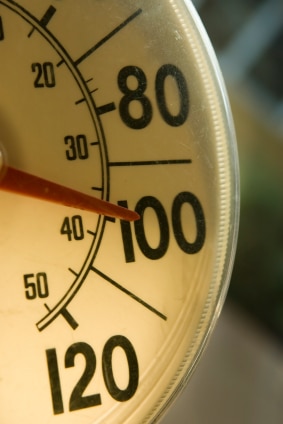Record Breaking Summer in Texas
During a typical summer, Houston has about four 100-degree days. This year, Houston blew past its 14-day triple-digit heat record set in 1980, now standing at 35 days of 100+ temperatures and counting. The average temperature in Houston for August is 87.7 degrees, a new record high set last year. Temperatures this year have surpassed that average by at least three degrees.
Dallas came up two days short of beating their 69-day record also set in 1980, but with road surfaces reaching in excess of 140 degrees, some road surfaces in north Texas buckled, with asphalt pushing upward creating speed bumps. In Richardson, utility poles began to lean due to loose soil caused by the ongoing drought.
Austin now stands at 70 days at or above the century mark, breaking their 100+ temperature streak record set in 1925, and temperatures in Texas aren’t expected to let up too much, even with some rain rolling across southeast Texas last night as high-pressure has steadily kept heavy rains out of the area.
Strain on the Grid
 All the high temperatures have put a heavy strain on the state’s electric grid as well. With widespread high temperatures across the state in early August, statewide electrical demand surged, setting new peak demand records three straight days during the first week of August. Emergency energy alerts were called for five days, asking for consumer assistance in reducing the electric load, nearly causing rolling blackouts for the second time this year.
All the high temperatures have put a heavy strain on the state’s electric grid as well. With widespread high temperatures across the state in early August, statewide electrical demand surged, setting new peak demand records three straight days during the first week of August. Emergency energy alerts were called for five days, asking for consumer assistance in reducing the electric load, nearly causing rolling blackouts for the second time this year.
This Tuesday and Wednesday, we’ve had to return to emergency alerts again. “A lot of students started back to school this week, so that would logically increase our load,” said Kent Saathoff, Vice President of Grid Operations at ERCOT, the Texas electric grid operator. On Tuesday, loads were 500 MW higher than last week when alerts were not issued, but we’ve been close all month It’s been very tight for the last several weeks, according to Saathoff.
ERCOT even brought online four mothballed generating units under reliability-must-run contracts, meaning that they will only run when real-time electric prices reach the market-set cap of $3,000 per megawatt-hour. According to statements made by ERCOT spokeswoman Dottie Roark in the course of a conference call to the media, two Garland Power units were available to help to add additional generation to the grid, while two additional NRG-owned units may not be available for a couple more weeks.
A few showers Wednesday night across southeast Texas did provide some comfort, but the end of high temperatures may not be within sight. “We may see more energy alerts. It strictly depends on how many generations we can keep meeting the high demands,” said Saathoff.
How High Temperatures Affect the Grid
- Increased electricity usage: With high temperatures across the state in all of the major metropolitan areas, air conditioning usage is maximized and contributes highly to the strain on the electric grid. Even a few degrees difference is enough to relieve strain on the grid so emergency alerts aren’t necessary.
- Increased generation strain: During extended periods of high load on the electric grid, generation units spin at full capacity and are more likely to break down or require additional maintenance. Additionally, producers may opt to postpone routine maintenance for units that are scheduled to be offline, resulting in reduced generation capacity.
- Decrease in cooling water effectiveness: With increased temperatures, pools and ponds that generation units use to cool equipment are warmer, providing less ability to keep equipment cool. Some generation units are required to reduce generation during certain times of the day or night to maintain the effectiveness of those ponds to keep equipment cool. The water shortage resulting from the drought is also partly to blame: “because reservoirs aren’t being replenished…it reduces the cooling ability of the water,” adds Roark.
- Reduction in wind generation: With high pressure causing stagnant air masses, wind generation is reduced, “Monday was 1840 MW, Tuesday was 1450 MW generated by wind. The wind today was 880 MW, that’s the lowest we’ve had since August 1, says ERCOT’s Roark.
Continue to Conserve
Due to high temperatures being forecast throughout the weekend, “we’re expecting high demand on the weekends, and as long as these high temperatures continue, we may have these emergency alerts, warned Dottie Roark. Please continue to “be very conscious of your usage, particularly between 3-7 PM. turn that thermostat up, delay washing dishes & clothes” adds Saathoff.
(Also, check on the blog for some energy conservation tips in case of an energy alert.)
Sources
“Houston Heat Likely to Break Record Again,” Houston Chronicle, August 25, 2011.
Heat Watch: Temperatures Are Going to Go Up, If You Can Believe It, SciGuy blog on Houston Chronicle, August 24, 2011.
100-Degree Heat Streak Ends Shy of Tying Record, KDFW, August 11, 2011.
Houston Sets Record with 15th Day at 100 Degrees, Houston Chronicle, August 15, 2011.
Record Heat Gives Utility Poles a Tilt, WFAA, August 24, 2011.
Heat Causes Roads to Buckle, KDFW, August 3, 2011.



